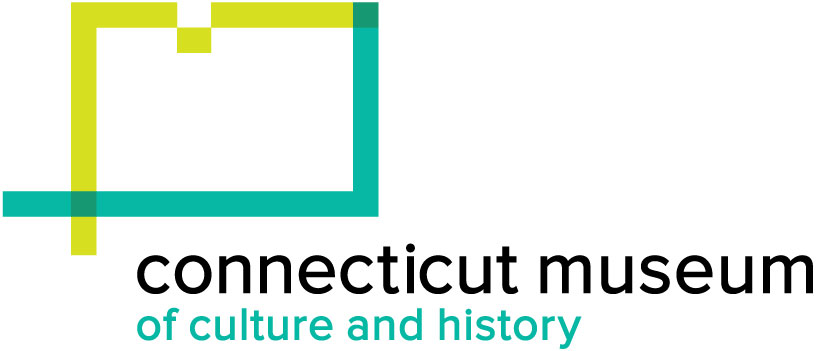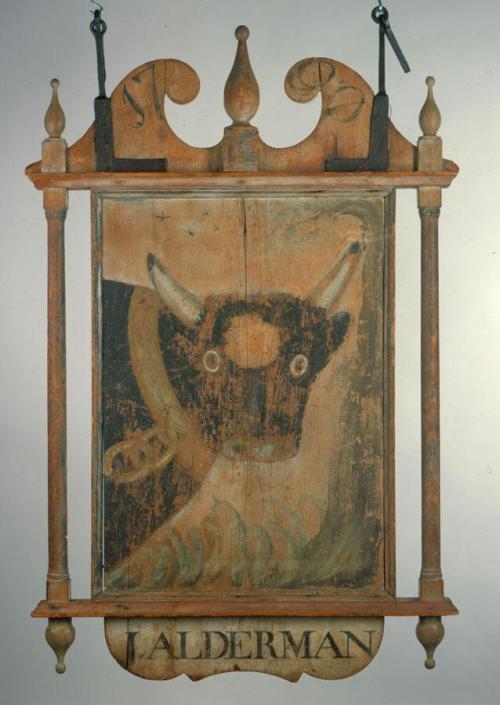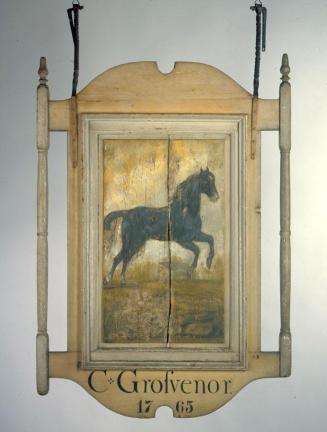Sign of the Bull's Head
Original OwnerOriginally owned by
Captain Aaron Bissell Sr.
(American, 1722 - 1787)
Original OwnerOriginally owned by
Dorothy Stoughton
(American)
Original OwnerOriginally owned by
Epaphrus Bissell
(American)
Original OwnerOriginally owned by
Captain Aaron Bissell Jr.
(American, 1761 - 1834)
Original OwnerOriginally owned by
John Alderman
(American, 1768 - 1856)
MakerMaker
Unknown
MediumPaint on pine board, iron hardware
DimensionsOther (height x width of sign only): 56 x 36 1/2in. (142.2 x 92.7cm)
ClassificationsPainting
Credit LineCollection of Morgan B. Brainard. Gift of Mrs. Morgan B. Brainard.
Object number1961.63.7
DescriptionImages: on both sides: head and neck of horned bull, extending to edge of board, with tree trunk, grass, flying birds, sky in background; side 2 has been repainted.
Construction: Single board; single, molded, horizontal rails; columnar posts; applied pediment brackets. Board is set vertically and hand-sawn at top and bottom to create decorative pediment and skirt profile; board passes through full-width mortice cut through each rail and is held by nails. Thin, columnar posts are tenoned vertically into both top and bottom rails. Three turned finials are saddled over the top of the board, with triangular extensions added to finish the lower points of the pediment; turned drops are doweled into the lower ends of the posts. Moldings are applied to the top and bottom of both faces and to the side edges of the signboard, creating a rectangular "picture frame."
Surface: Side 2 (with buckshot punctures) was overpainted in the early 20th century, using a thick, glossy paint in highly contrasting shades of black, white, green, blue, and brown. The overpainting altered side 2 significantly, reinstating the earlier date and name, and creating a streamlined, hard-edged, modernistic counterpart to the softly weathered original. On the turned columns, horizontal rails, and framing moldings, repainting extended only to the picture plane, leaving these sections curiously two-toned when viewed directly on edge. The bull's heads are "mirror images," and may have originally been drawn with a template, although the overpaint makes accurate reading difficult.
Construction: Single board; single, molded, horizontal rails; columnar posts; applied pediment brackets. Board is set vertically and hand-sawn at top and bottom to create decorative pediment and skirt profile; board passes through full-width mortice cut through each rail and is held by nails. Thin, columnar posts are tenoned vertically into both top and bottom rails. Three turned finials are saddled over the top of the board, with triangular extensions added to finish the lower points of the pediment; turned drops are doweled into the lower ends of the posts. Moldings are applied to the top and bottom of both faces and to the side edges of the signboard, creating a rectangular "picture frame."
Surface: Side 2 (with buckshot punctures) was overpainted in the early 20th century, using a thick, glossy paint in highly contrasting shades of black, white, green, blue, and brown. The overpainting altered side 2 significantly, reinstating the earlier date and name, and creating a streamlined, hard-edged, modernistic counterpart to the softly weathered original. On the turned columns, horizontal rails, and framing moldings, repainting extended only to the picture plane, leaving these sections curiously two-toned when viewed directly on edge. The bull's heads are "mirror images," and may have originally been drawn with a template, although the overpaint makes accurate reading difficult.
Collections
David Bissell's inn (during the ten-year period of its existence) was located at the ferry landing itself, presumably drawing off some of the river traffic.
John Alderman's inn was located three doors south of Aaron Bissell's, on the Hartford road, possibly on Bissell property. Alderman is not recorded as owning a house in East Windsor; his only known property being a 1-1/2 acre lot on the west side of the road, where he set up a distillery.
Status
On view1772-1786
1827-1836
1820-1838














